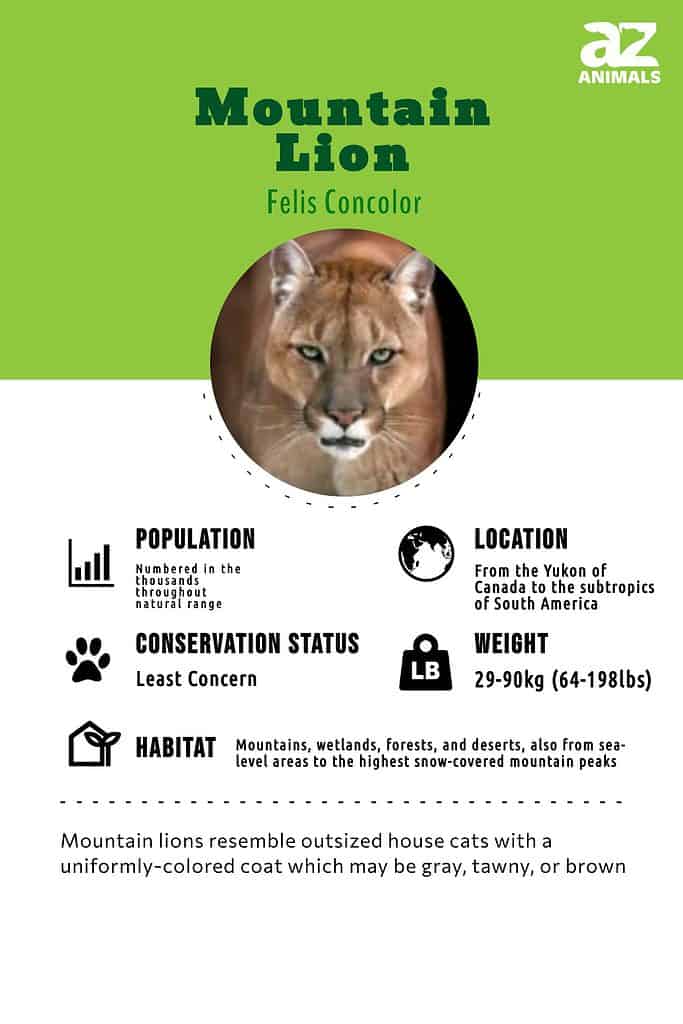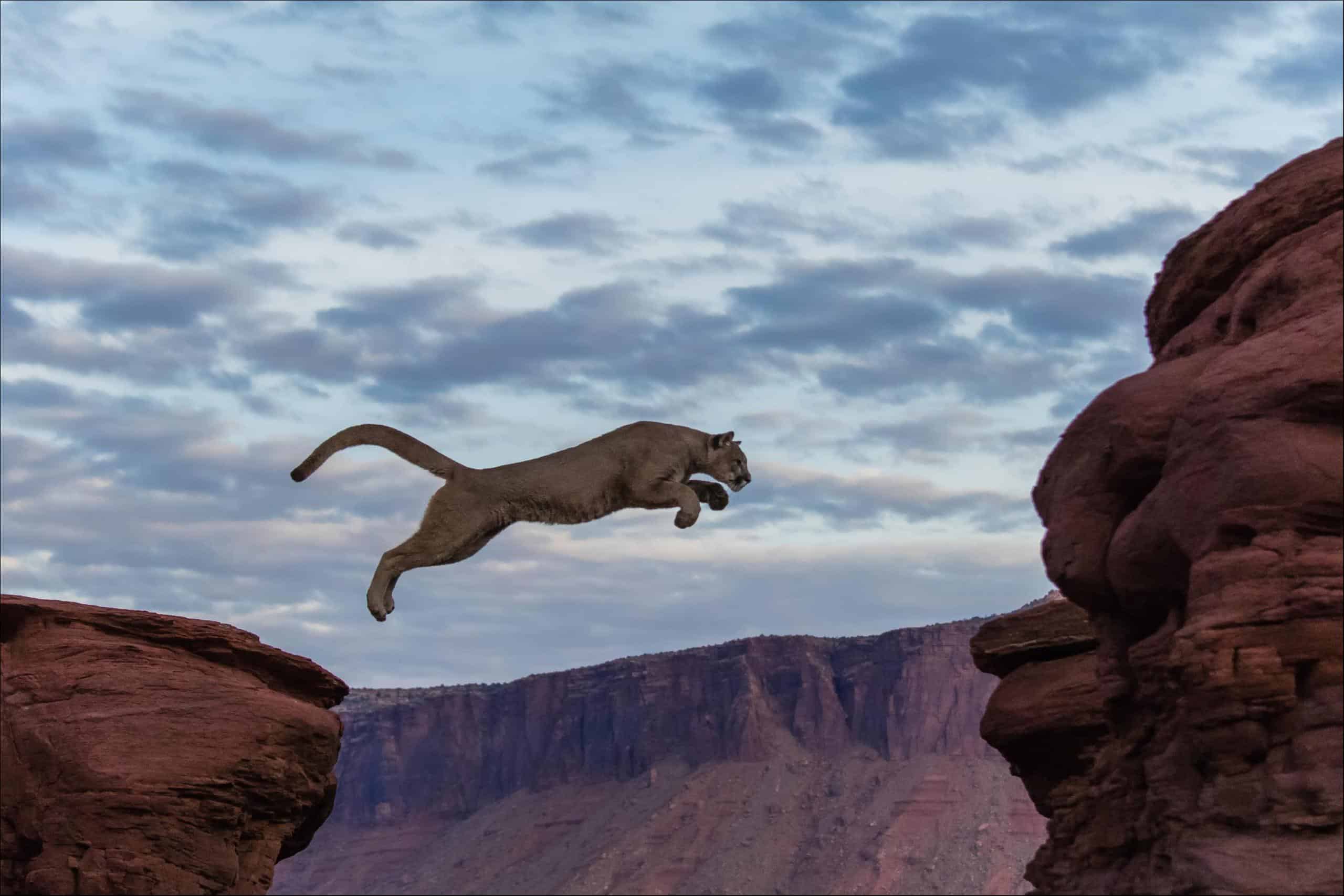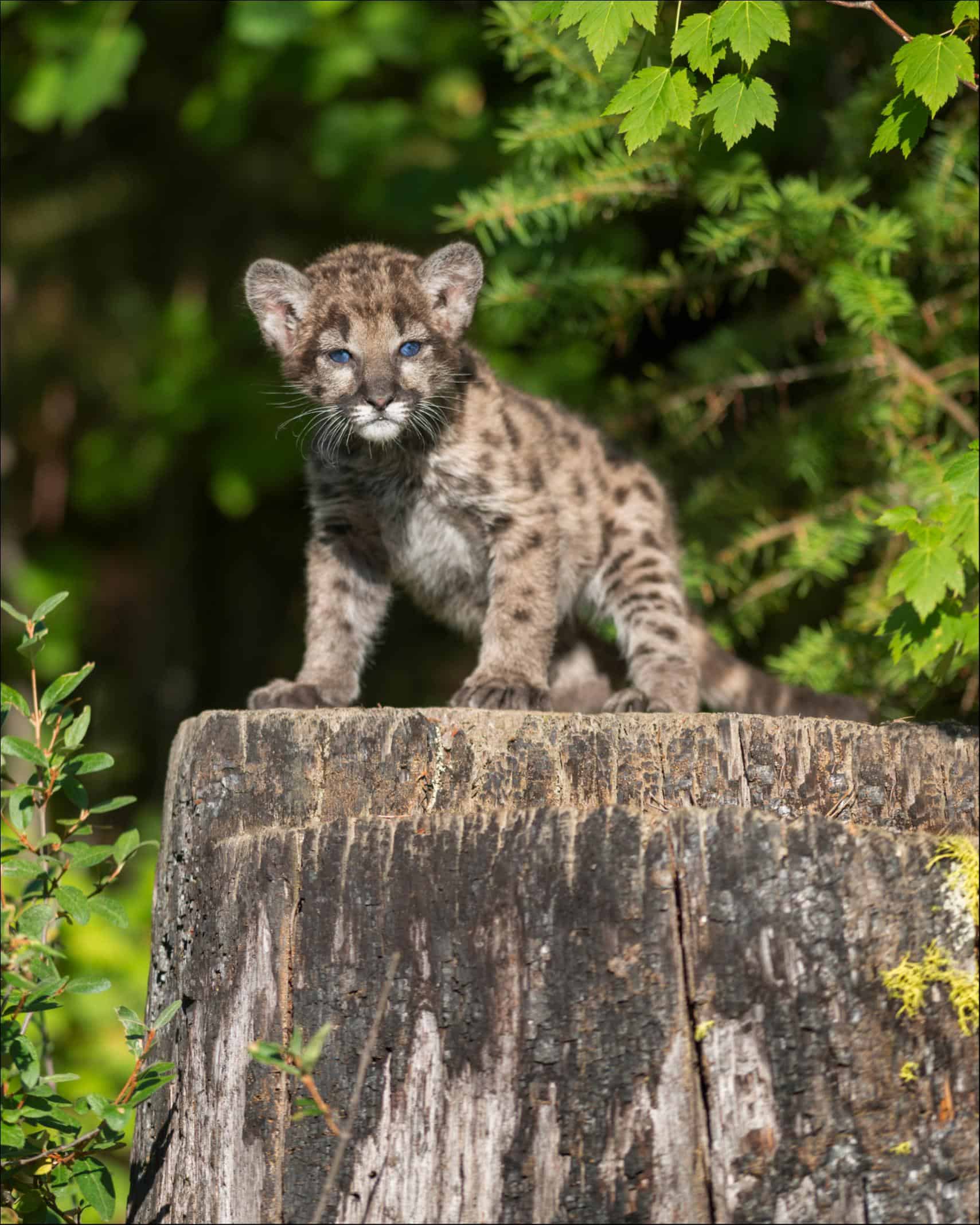Mountain Lion
Felis Concolor
Has no real natural predators!
Advertisement
Mountain Lion Scientific Classification
- Kingdom
- Animalia
- Phylum
- Chordata
- Class
- Mammalia
- Order
- Carnivora
- Family
- Felidae
- Genus
- Puma
- Scientific Name
- Felis Concolor
Read our Complete Guide to Classification of Animals.
Mountain Lion Conservation Status
Mountain Lion Facts
- Main Prey
- Deer, Elk, Beavers
- Litter Size
- 3
- Habitat
- Forest and mountainous regions
- Predators
- Human, Grizzly Bear
- Diet
- Carnivore
View all of the Mountain Lion images!
“Can jump to the height of a two-story building!”
The mountain lion is a large, tan colored cat species native to North America, Central America and South America. In the United States, these cats live primarily in western states and Florida. Also called by the name cougar, puma, catamount and panther, mountain lions are animals that thrive in many habitats. They live in more geographies than any other Western Hemisphere mammal, besides humans.

Top Facts
- Cry like house cats: Mountain lions do not roar, instead using a distinct mountain lion scream, growl, hiss, meow and purr
- Changing eye color: Cubs are born with blue eyes that change to yellow by age 16 months
- Solitary life: These lions prefer to live alone on about 30 square miles of territory
- Fast runners: They can run at speeds up to 50 miles per hour
Want more mountain lion facts? Give ‘11 Incredible Mountain Lion Facts‘ a read for a deep dive into the most incredible facts about these majestic animals!
Scientific Name
The mountain lion’s scientific name is Puma concolor, from the Spanish word puma of Latin origin. The name translates to mean “mountain lion” in Spanish, French, German and other Latin-based languages. The big cat’s phylum is Chordata, in the class Mammalia, order Carnivora, family Felidae and genus Puma. Early Spanish explorers of the Americas called the cat “leon,” meaning lion and “gato monte, meaning mountain cat. Incas called it “puma,” while early South American Indians called it “cuguacuarana,” from which the word “cougar” comes. Most scientists prefer to call these cats “pumas.” These cats have about 40 names in the English language, including panther, puma, cougar, catamount, painter, mountain screamer, red tiger, Mexican lion and American lion. Six subspecies live in North America, Central American, eastern South America, northern South America, central South America and southern South America.
Types
There are two main mountain lion subspecies:
- South American cougar (Puma concolor concolor): This subspecies is found in countries which include Argentina, Bolivia, Chile, Colombia, Peru, and Venezuela.
- North American cougar (Puma concolor couguar): This subspecies lives in Canada, Central America, Florida, Mexico, and the western United States.
Appearance & Behavior
These predators look very much like over-sized short-hair house cats. They have small heads with short faces. Ears are rounded and small. Their bodies are long and sleek, with long necks and tails. Puma legs are powerful, suited to rapid increase of speed and made for pouncing. The cats’ teeth seize their prey, tearing and slashing the meat.
The average mountain lion is an animal that ranges from about 3’3″ in length to about 5’5″. But with their tails, some males measure as long as nine feet and females up to seven feet. The cats stand between two feet and 2’6″ from the ground to their shoulders. In adulthood, females weigh from 80 to 100 pounds and males from 125 to 160 pounds. Mountain lion color in the United States is most commonly tan. Throughout the Americas, their color ranges from a tawny color to a bluish gray. Their bellies, inner legs and throats are always lighter in color, with their noses and tails having black or dark edges. Babies are born with spots to camouflage them in the wild. These spots fade at about six months. Their blue eyes also change to yellow by the age of 16 months.

Mountain lions are solitary by nature. They sometimes share territory with one other puma, but prefer a 30 square mile range to call their own. Some mountain lions maintain a territory of up to 125 square miles. They live in habitats of all kinds in the Western Hemisphere, from mountainous regions to the swamps of Florida. Humans rarely see mountain lions, as they are nocturnal and prefer to remain hidden. But they are stealthy creatures that stalk their prey. Pumas are very intelligent. They avoid humans whenever possible.
Mountain lions are at the top of the food chain. They keep deer populations in balance and even help reduce the number of vehicle accidents involving deer. Although brown bears will kill and eat mountain lions, sometimes the lions win in fights against these giant bears. Humans and domestic animals must watch out for mountain lions, when we cross into their habitats. Puma avoid humans whenever possible. But people sometimes cross their paths on hiking trails or out in the wilderness.
To know how dangerous mountain lions are, read here.
Evolution
Experts assert that the mountain lion’s ancestor first appeared in Asia about 11 million years ago. Three million years later, it would cross the Bering land bridge to North America. In its new home, it would differentiate into different genetic strains, including those responsible for wild and domestic felines, ocelots, oncillas, lynxes, and mountain lions.
About 2 – 4 million years ago, these cats entered South America, crossing the Isthmus of Panama. However, the population of mountain lions in North America diminished, and those which are found there today are actually their relatives which returned to their original home from the southern part of the Americas.
Between 6 to 4 million years later, these felines would make their way to South America by way of the Isthmus of Panama.
It is worth noting that certain experts believe that the North American population of pumas eventually dwindled and that present-day cougars are actually arrivals which retraced their steps from South America to North America at a later date.
Habitat
Mountain lions live throughout the Americas, from the Yukon of Canada to the subtropics of South America. No other American mammal, except humans, spans such a wide land range. They can live in almost any type of habitat, such as mountains, wetlands, forests and deserts, also from sea-level areas to the highest snow-covered mountain peaks. Although they prefer 14 western states of the United States, puma in the U.S. are also found in low numbers in Florida. These cats also roam as far as the northeastern states from time-to-time. Mountain lions live in areas with dense shrubbery, undergrowth and other plant life for cover. If they feel threatened, they leave the area. The average lifespan for a wild mountain lion is about ten years. But in zoos, many live for 20 or more years. Because of sport hunting in some regions, the cats in those areas only live to about five years of age.
Throughout their lifetime, mountain lions prefer to live alone. Only for mating and parenting do they break this rule. They mark their territory by urinating on piles of leaves, pine needles or grass and clawing trees. This tells other lions to stay away. If another lion crosses into the territory, the two will fight to their death if necessary. The cats’ coat color varies from region to region. Where they live determines this color. With the ability to blend into their surroundings, mountain lions easily prey on deer and small mammals.
They eat coyotes, raccoons, rabbits and porcupine. To preserve their killed prey and protect it from scavengers, they bury it and return to feed off of it for several days. Mountain lions’ large hind legs have greater muscle mass than their front legs. This enables them to jump up to 18 feet into a tree and 20 feet up or down a hill. They run very fast, with their flexible spine allowing them to change direction and move around obstacles quickly. Their large paws keep them steady, with sharp claws for defense and attacking prey. Keen eyesight helps them find their prey.
Predators & Threats and Diet
The biggest threats to mountain lions are humans. These cats are apex predators, near the top of the food chain. They are sometimes killed by brown bear or as part of territory fights with other mountain lions. Mountain lions once lived from the east coast of America to the west coast. But people feared the big cats and believed them to be predators of livestock. So by the 1940s, many states paid bounties for killing of the lions. Each pelt once brought a reward of $25 to $35. This reduced their numbers by far, restricting the cat population mostly to the western coast and a small number in Florida. Despite laws in place to protect them in many parts of the U.S., some people still illegally trap, poison and shoot the lions on sight. Hunting is still legal in some form in many states, such as Utah, Idaho, Wyoming, Montana, Colorado, New Mexico, Nebraska, North Dakota, South Dakota, Nevada, Arizona, Texas, Washington and Oregon.
Mountain lions are carnivores that are apex predators across much of their environment. Their favorite meals include mule deer, badgers, raccoons, and other mammals. For a complete analysis of their diet, give our ‘What Do Mountain Lions Eat? 20 Animals in Their Diet‘ page a read!
Reproduction, Babies and Lifespan
Mountain lion females can mate with several males in one reproductive season, called estrus. Typically, the female prefers to mate with a male from an overlapping territory. The three to 10 days of a mating period is the only time humans see males and females together. Otherwise, they remain solitary animals and avoid contact. For both females and males, sexual maturity occurs at about one to 2.5 years old.
Females do not try to reproduce until they have established their own territory. Females with cubs move from one place on their territory to another every few weeks. This helps her protect the cubs from roaming males and other predators. Mating occurs throughout the year, when the female is in estrus. But most litters are born during the warm months of summer, particularly July to September. Females produce a litter every 1.5 to two years, on average. But if she loses a litter, she quickly enters estrus again. Gestation, also called pregnancy, for a mountain lion is about 90 days. Gestation for a mountain lion is short compared to other large land animals. But it compares closely to other lions and their tiny cousins, domestic house cats.
- Human: 270 days
- Brown bear: 215 days
- Giraffe: 430 days
- African lion: 110 days
- House cat: 58 to 67 days
- Mountain lion: 90 days
Most litters include two to three spotted, blue-eyed cubs, sometimes called kittens. Sometimes only one or as many as four are born. By six months of age, the fur has changed to a tawny, unspotted coat like adults. Their blue eyes change to yellow by the age of 16 months. Kittens nurse for three months. They start eating a meat at one and a half months, then eating meat exclusively after weaning. As they grow in their adult coats at six months, they start hunting with their mother. Babies are cared for by their mother until one to two years of age, when the cubs must strike out on their own. Where hunted, such as in U.S. states that permit some hunting of mountain lions, the average lifespan for one of these cats is about five years. Left to live a natural lifespan in the wild, most live about 13 years. The average lifetime for these big cats in zoos is about 19 years, although some live beyond 20.

Population
As of 2015, the existing mountain lion population is listed as decreasing due to diminishing habitat, but stable. Overall, the species is not endangered. This is with a few exceptions, including the subspecies of Florida panthers and the now extinct eastern cougar. The eastern cougar was declared officially extinct in 2011 by the U.S. Fish & Wildlife Service. In Florida, only 160 panthers remain. One of the biggest problems in mountain lion conservation is the lack of clear lion counts over the past decades. States and other countries are working now to establish clear counts, such as in California. But thousands of these cats are known to exist in the U.S., as well as throughout Central America, Canada and South America. In California, the Fish and Wildlife’s Wildlife Investigations Laboratory has set a goal to know a precise statewide mountain lion count by 2022.
Additionally, there are 15 US states that have a stable breeding population of mountain lions.
View all 164 animals that start with MMountain Lion FAQs (Frequently Asked Questions)
Panther vs mountain lion: what's the difference?
Mountain lions go by a number of names and are sometimes even called panthers. However, the name “panther” can be applied across a number of big cats and is often used when referring to the melanistic jaguar that’s doesn’t have visible spots.
Are mountain lions carnivores, herbivores, or omnivores?
Mountain lions are carnivores. They prefer white tail and mule deer meat over all other food, with deer making up about 80 to 90 percent of their diet. When they cannot find or kill a deer, these predators will prey on any animal. They eat elk, moose, bighorn sheep, porcupine, rabbit, raccoon, coyote, rodents, reptiles and birds. If all else fails or as an easy snack, some even eat insects. When eating large game, the cats first devour the heart, liver and lungs.
Do mountain lions attack humans?
Mountain lions avoid humans whenever possible. If they encounter a human, the cats have been known to stalk and even kill people as prey. They will attack if they feel threatened on their territory. But this happens only as frequently as a human is struck and killed by lightning. Only about a dozen mountain lion attacks occur each year in the U.S., with about three to four deaths per year. Considering the lions cover more ground than any other non-human mammal in the Western Hemisphere, this is a very low number of encounters, attacks and deaths.
What should you do if you see a mountain lion?
If you see mountain lion tracks, start talking out loud, making noise and otherwise behaving in a manner that will startle a nearby cat. When a human encounters a mountain lion, the best advice is to lock eyes with it and wave your arms to appear larger while standing tall. Throw rocks or other items at it and make a lot of noise, but stay in one spot. You should never run from a mountain lion or turn your back to it. Doing so usually makes them engage in a chase. The lion will eventually run away if you give it the space and opportunity to do so. Sightings of these cats are more common than ever, with some puma coming out of the mountains of California, Washington, Colorado and Idaho to prey on residents’ pets. But these sightings occur with the same odds of a human being struck by lightning, so they are rare.
A bear spray can also be effective in deterring mountain lions.
What is the history of mountain lion attacks in North America?
In the past 100 years, 125 mountain lion attacks have been documented in all of North America, with 27 being fatal. Between 1890 and 1970, only ten fatalities were listed. One of those was determined to be a hoax, in 1909. Three people died in the 1970s, two in the 1980s, six in the 1990s, three in the 2000s and two since 2010. The last two deaths were in Washington and Oregon.
What is the difference between a mountain lion and a cougar?
Mountain lions include six subspecies, of which cougar is one of those subspecies. The cougar is the North American Mountain Lion, Puma concolor cougar, which lives throughout the U.S. The mountain lion is in the Guinness Book of World Records, as the animal with the most nicknames. “Cougar” is one of the 40 nicknames for mountain lions, along with puma, panther, catamount, mountain screamer, Mexican lion, painter, red lion and American lion.
Are mountain lions and pumas the same?
Puma is both a nickname for mountain lions and an abbreviation of the species name for these stealthy, sleek big cats of the Americas. Their scientific name “Puma concolor” is where the term puma comes from, the Spanish word for “mountain lion.”
What Kingdom do Mountain Lions belong to?
Mountain Lions belong to the Kingdom Animalia.
What phylum do Mountain Lions belong to?
Mountain Lions belong to the phylum Chordata.
What class do Mountain Lions belong to?
Mountain Lions belong to the class Mammalia.
What family do Mountain Lions belong to?
Mountain Lions belong to the family Felidae.
What order do Mountain Lions belong to?
Mountain Lions belong to the order Carnivora.
What genus do Mountain Lions belong to?
Mountain Lions belong to the genus Puma.
What type of covering do Mountain Lions have?
Mountain Lions are covered in Fur.
In what type of habitat do Mountain Lions live?
Mountain Lions live in forests and mountainous regions.
What is the main prey for Mountain Lions?
Mountain Lions prey on deer, elk, and beavers.
What are some predators of Mountain Lions?
Predators of Mountain Lions include humans and grizzly bears.
What is an interesting fact about Mountain Lions?
Mountain Lions have no real natural predators!
What is the scientific name for the Mountain Lion?
The scientific name for the Mountain Lion is Felis Concolor.
What is the lifespan of a Mountain Lion?
Mountain Lions can live for 10 to 20 years.
How many babies do Mountain Lions have?
The average number of babies a Mountain Lion has is 3.
How fast is a Mountain Lion?
A Mountain Lion can travel at speeds of up to 30 miles per hour.
Who would win a fight between a mountain lion and a coyote?
A mountain lion would win a fight against a coyote. It has the size, power, and ability to kill a lone coyote. The fight could start with the mountain lion stalking the coyote and swiftly ending the fight with one decisive ambush.
Who would win a fight between a mountain lion and a bear?
A bear would beat a mountain lion in a fight. These creatures have no venom or special attacks, so this fight is not likely to be over in a single blow. Thus, it’s a knock-down, drag-out fight where the bigger, stronger, and deadlier creature wins. The bear fits the bill better than the mountain lion.
Who would win a fight between a mountain lion and a wolf?
A mountain lion would win a fight against a wolf. Mountain lions have a size advantage, a power advantage, and more weapons in their arsenal to kill a wolf. If the mountain lion successfully ambushed a wolf, the fight is immediately over, and the wolf is dead due to a pierced skull or ripped throat.
Who would win a fight between a jaguar and a mountain lion?
A jaguar would win a fight against a mountain lion.
This fight is going to end with one big cat wrapping its mouth around the other’s neck. Jaguars are larger and more powerful on average, have a speed advantage, know how to attack from cover, and have a far more powerful bite.
Thank you for reading! Have some feedback for us? Contact the AZ Animals editorial team.
Sources
- David Burnie, Dorling Kindersley (2011) Animal, The Definitive Visual Guide To The World's Wildlife / Accessed November 10, 2008
- Tom Jackson, Lorenz Books (2007) The World Encyclopedia Of Animals / Accessed November 10, 2008
- David Burnie, Kingfisher (2011) The Kingfisher Animal Encyclopedia / Accessed November 10, 2008
- Richard Mackay, University of California Press (2009) The Atlas Of Endangered Species / Accessed November 10, 2008
- David Burnie, Dorling Kindersley (2008) Illustrated Encyclopedia Of Animals / Accessed November 10, 2008
- Dorling Kindersley (2006) Dorling Kindersley Encyclopedia Of Animals / Accessed November 10, 2008
- David W. Macdonald, Oxford University Press (2010) The Encyclopedia Of Mammals / Accessed November 10, 2008


















